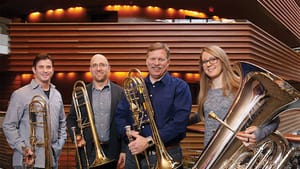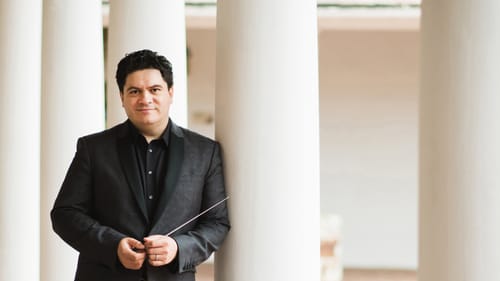Stay in the Loop
BSR publishes on a weekly schedule, with an email newsletter every Wednesday and Thursday morning. There’s no paywall, and subscribing is always free.
New work and an old surprise
Philadelphia Orchestra presents 'Beethoven, Brahms, and Brass'

Everything’s coming up concertos for Philadelphia-based composer Jennifer Higdon, whose Low Brass Concerto debuted this week with the Philadelphia Orchestra under the baton of Cristian Măcelaru. She also has four more works in that form opening around the country in the next few months. Higdon is at the height of her career, and she’s not one to rest on her laurels, which include a Pulitzer Prize and several Grammy Awards.
Măcelaru, music director and conductor of the Cabrillo Festival of Contemporary Music, highlighted four of the orchestra's low-brass players: Nitzan Haroz and Matthew Vaughn, trombones; Blair Bollinger, bass trombone; and Carol Jantsch, tuba. The Philadelphia Orchestra co-commissioned the work with the Chicago and Baltimore Symphony Orchestras.
Bold and brassy
Billed as one movement, the concerto is conceptualized as an uninterrupted, three-movement work. It’s bright and uplifting in the first section; lyrical and reflective in the second; and full of gaiety, rhythm, and fire in the third. Its opening recalls the brass chorales of Giovanni Gabrieli, evoking images of San Marco at dawn: a haunting, spiritual unfolding with a reverent responsory in the strings.
The first section expands boldly, gaining in velocity and drive, with discord dissolving into melody. Măcelaru balanced the powerful expressions of the four brass players against the full orchestra, allowing the soloists to shine. A duet between Bollinger and Jantsch was especially captivating. These are musical forces we rarely encounter in such attractive combination.
Haroz and Vaughn brought an unexpected level of warmth and tenderness to the second section. The work tingles with delightful percussive effects, while the concluding section featured some swaggering syncopations in the timpani (Don S. Liuzzi). Overall, the concerto is a wonderful example of fresh and new music that honors the past and appeals to many listeners.
The program opened and closed with Hungarian-style dances by Kodály and Brahms. I thought the Kodály was particularly luminous and emotionally involving; the Brahms, sometimes thrilling. But not all dances are equally captivating.
A revelation
The other main work on the program was Beethoven’s Symphony No. 8 in F major. I have to confess, I have never liked the Eighth. It was composed in 1812, one of those “in-between” periods in Beethoven’s life.

He was trying to break up his brother’s relationship with a woman he viewed as “common,” and at the same time was frustrated in his own quest for a romantic partner (this was the year of the "Immortal Beloved" letter). The Archduke Trio and Les Adieux Sonata were behind him, he had just completed the Seventh Symphony, and his deafness was firmly entrenched. He was only 41, deaf, alone, and stuck.
Yet, from the first chords, I found that Măcelaru’s version of the Eighth grabbed my attention. The work is often cited as an example of Beethoven’s wit, which can be heavy-handed, but in this interpretation, that wit was charming and light. The piece contains multiple unexpected measures of silence, for example, and mischievous triplets in which the second note drops down an octave, only to bounce right back up like a yo-yo.
Perhaps years of not listening to the Eighth gave me a greater appreciation for its wisps of melody with odd twists, like a sudden D-flat in an F major tune. Even the annoying “metronome mimicking” of the second movement had a whimsical quality to it I never noticed in recordings.
There is an imaginative trio in the third movement with two horns and clarinet, beautifully expressed in this performance. The whispered ending of the first movement and self-parody of the fourth movement’s seemingly interminable conclusion were some of the effects I’d ignored through years of thinking, “I don’t like that!”
I realized, too, I had been missing live performances of the Eighth. It is not a popular work, so chances to hear it performed and interpreted by an insightful conductor are few. Watching on YouTube or listening to CDs and vinyl are like eating a heated-up frozen dinner compared to the sizzling, juicy cuisine of a master chef. Now I’m hungry for seconds.
What, When, Where
Beethoven, Brahms, and Brass. Nitzan Haroz, trombone; Matthew Vaughn, trombone; Blair Bollinger, bass trombone; Carol Jantsch, tuba; Cristian Măcelaru, conductor. Dances of Marosszék by Zoltán Kodály; Low Brass Concerto, by Jennifer Higdon; Symphony No. 8 in F major, Op. 93, by Ludwig Van Beethoven; Select Hungarian Dances (Nos. 2, 4, 8, 16 and 10), by Johannes Brahms. Philadelphia Orchestra. February 22-24, 2018, at the Kimmel Center's Verizon Hall, 300 S. Broad Street, Philadelphia. (215) 893-1999 or philorch.org.
Sign up for our newsletter
All of the week's new articles, all in one place. Sign up for the free weekly BSR newsletters, and don't miss a conversation.

 Linda Holt
Linda Holt